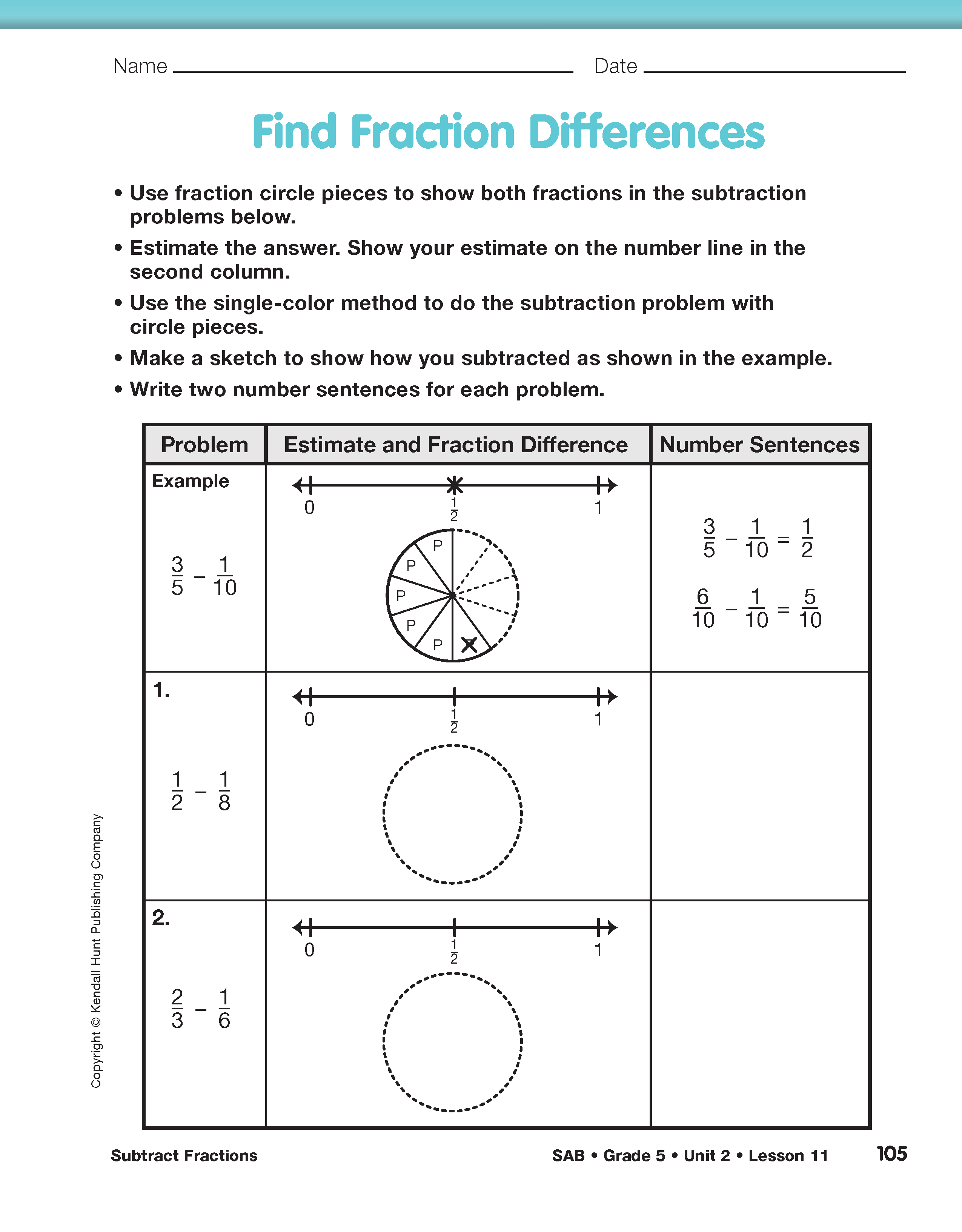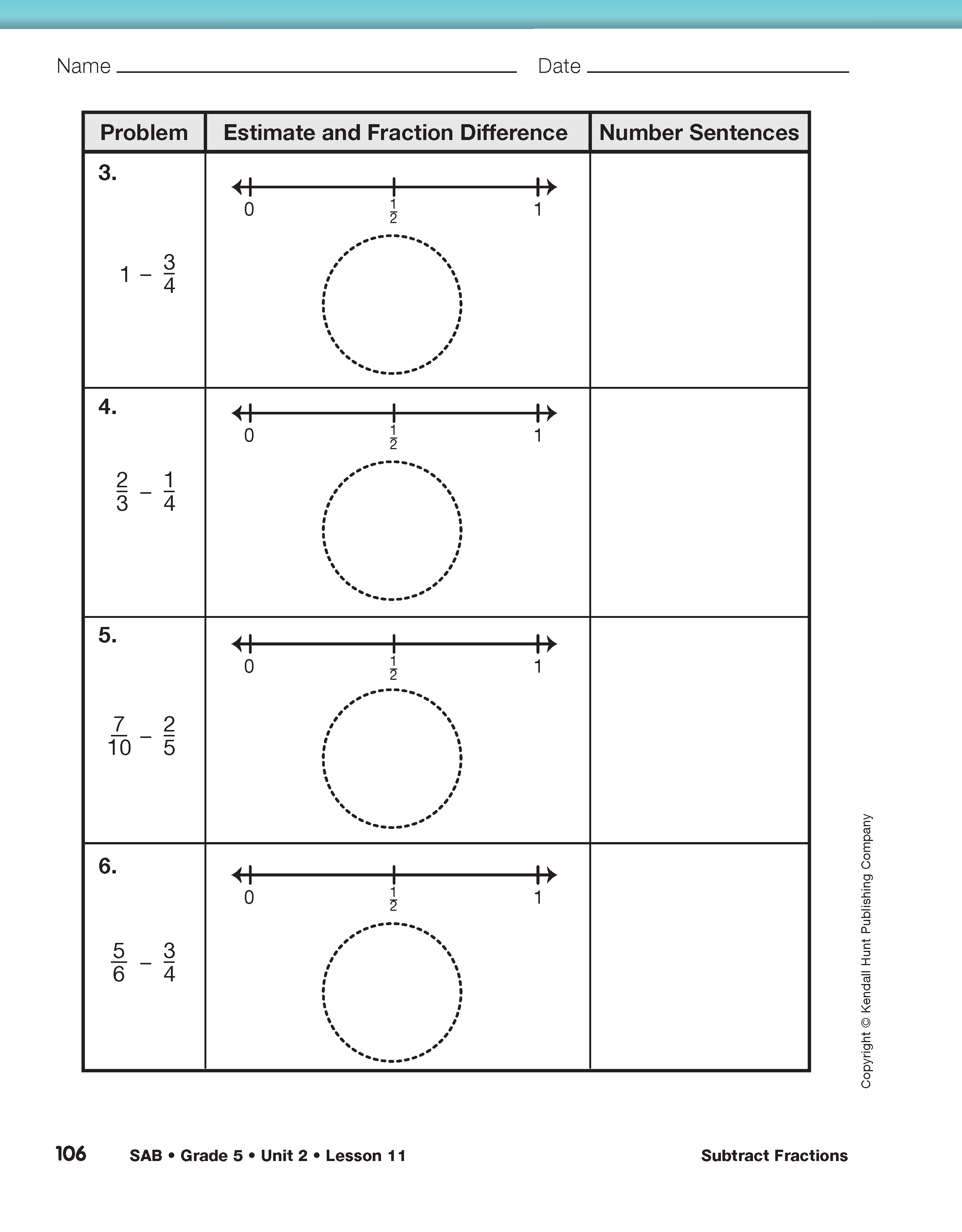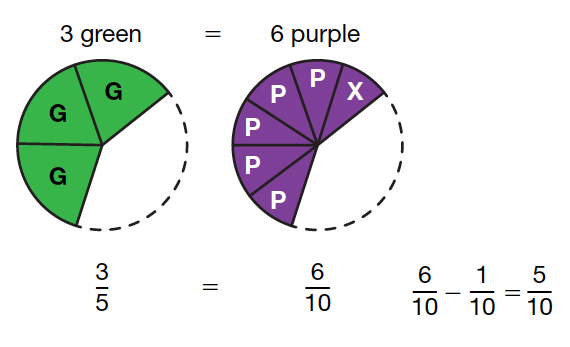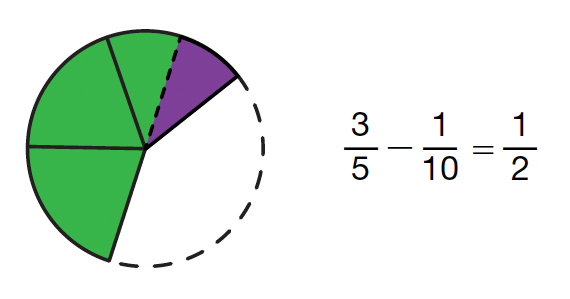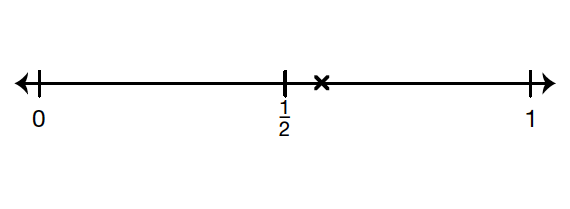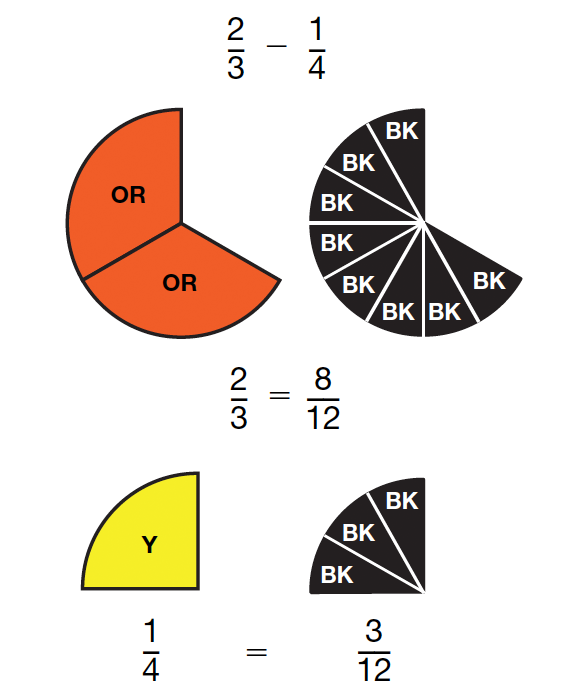Display the following addition problem:
3/5 + 1/10 = ?
Ask students to model this problem with a partner using circle pieces. Ask one or two students to show the solution to the problem and describe their strategies for solving it.
Next write the problem as a subtraction problem.
3/5 − 1/10 = ?
Ask students to show the first fraction and the second fraction with circle pieces but not to find an answer yet.
- How is the second problem different from the first problem? (The second is a subtraction problem; the first is addition. In the first problem you combine pieces; in the second problem you will have to take away pieces.)
- Do you think the answer to this problem is closer to 0, 1/2 , or 1? ( 1/2 )
- Why do you think so? (Possible response: 3/5 is a little more than 1/2 , and 1/10 is a small piece, so subtracting it will still be close to 1/2 .)
- Find the exact answer to 3/5 − 1/10 .
Ask students to find an exact answer to the problem using circle pieces. As you circulate, get a sense of the variations in students' approaches to the problem. For example, some students may use a take-away strategy, replacing the 3 green pieces with 6 purple pieces, and then taking away one purple piece. As you discuss this method with the class, call it the “single-color method.” See Figure 1.
Others may find the difference between the two quantities by comparing the shape of 3 green pieces to the shape of 1 purple piece and seeing that the green pieces are exactly 1/2 of a circle bigger than the 1 purple piece. See Figure 2. Have two or three students share their solutions with the class. Try to select students whose solutions reflect different strategies.
After discussing students' solutions, ask:
- What is different about the way you solved the subtraction problem from the way you solved the addition problem? (Possible response: In the first problem you put pieces together and in the second problem you have to take pieces away.)
- What is the same about the way you solve the two problems? (Possible response: For both, you need to replace pieces to get a single color.)
- Show how to solve this using multiplication to find a common denominator. ( 3/5 × 2/2 = 6/10 , 6/10 − 1/10 = 5/10 )
- What are possible number sentences for this subtraction problem? ( 3/5 − 1/10 = 1/2 ; 3/5 − 1/10 = 5/10 ;
6/10 − 1/10 = 5/10 )
- How well did your estimate match your exact answer?
Display the first Find Fraction Differences page in the Student Activity Book. Read through the instructions with the class. See Content Note. The example problem in the first row is the problem used in the opening discussion. Have students work with partners to complete Questions 1–6.
The number line in the top of each box in the second column is a tool to help students estimate their answers. The number line allows a slightly more specific estimate than a simple comparison to a benchmark number. For example, the number line in Figure 3 shows an estimate for 3/4 − 1/6 that is close to 1/2 but slightly more. Another student might locate an estimate that is also near 1/2 but slightly less. Without a number line, both students might say that the answer is close to 1/2 , but the number line would show that they have different understanding about the problem.

The instructions for the Find Fraction Differences pages in the Student Activity Book ask students to solve the problems using the single-color method. As with fraction addition, this method eventually leads students to a structured procedure for finding common denominators (though the term is not used at this point). The procedure for finding common denominators will be developed formally later. At this point, it is important that students become comfortable adding part-whole fractions using circle pieces rather than moving to a numerical algorithm too soon. Consistent use of circle pieces to solve problems helps students develop an intuitive sense of the relative sizes of fractions and fraction differences. It also helps students make sense of the numerical procedure for fraction subtraction when it is formally introduced.
At the same time, writing number sentences for each fraction circle model helps build the connection between the model and the abstract computation, laying the groundwork for numerical procedures in later units.
As they work, circulate and ask students to justify the estimates they show on the number line:
- What is your estimate? (Students may respond with answers such as, “a little less than 1,” or “about halfway between 0 and 1/2 .” Check to make sure the location marked on the number line matches a student's estimate.)
- Explain why you think that is close to the answer.
Ask several students to share their solutions with the class.
Use Question 4 and Figure 4 to discuss finding common denominators.
- When solving 2/3 − 1/4 , can you replace 2 orange pieces with yellow pieces? (no)
- Can you replace 1 yellow piece with orange pieces? (no)
- How did you know which single color to use to solve 2/3 − 1/4 ? (Possible response: I thought about the circle pieces. I could replace 2 orange pieces with all black pieces, and I could replace 1 yellow with all black pieces.)
- Is it easier to subtract fractions with like or unlike denominators? Why? (like; Possible response: The numerators tell the number of parts to subtract. The denominators tell the type of parts, so you just subtract the numerators to find the difference.)
- How is using the single-color method to subtract similar to finding common denominators and then subtracting? (Possible response: They both use the same idea. Exchanging fraction circle pieces so that you are just using one color is like finding equivalent fractions so that you can subtract using just one denominator.)
Display 2 orange pieces and 1 yellow piece to model the problem. Write 2/3 − 1/4 .
- Two orange pieces is what fraction of the red circle? ( 2/3 )
- One yellow is what fraction of the circle? ( 1/4 )
- One black piece is what fraction of the circle? ( 1/12 )
- What do you notice about the numbers 3, 4, and 12? (3 × 4 = 12; 3 and 4 are both factors of 12. 12 is a multiple of both 3 and 4.)
- If you could rename both fractions as twelfths it would be easier to subtract. How many twelfths are equivalent to 2/3 ? How do you know? ( 2/3 = 8/12 ; Possible response: I think about circle pieces. 3/3 is one whole and 12/12 is one whole. That means 4 twelfths or 4 blacks are the same as 1/3 , so 8 twelfths or 8 blacks are the same as 2/3 .)
Write 2/3 × 4/4 = 8/12 .
- Is there another way to find out how many twelfths are equivalent to 1/4 ? Can you use a multiplication strategy? (Possible response: You need to multiply the numerator and the denominator in 1/4 by the same number to make twelfths. I see that the denominator 4 times 3 equals 12 in the equivalent fraction, so I multiply the numerator 1 times 3 to get 3. 1/4 = 3/12 .)
Write 1/4 × 3/3 = 3/12 . Then rewrite the original problem to read
8/12 − 3/3 = 5/12 . Use similar prompts to discuss Questions 5–6.













